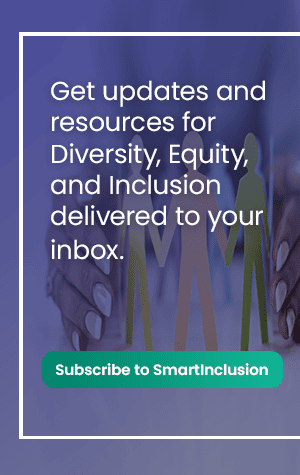Sylvia Dahlby, DE&I Champion at SmartSesarch, talks with Omari Jahi Aarons, Managing Partner of the Aarons Group, a workplace diversity & inclusion consulting firm, on what it means to model a culture of inclusion in recruiting.
This installment is part of a series of video conversations with Human Resources thought-leaders and industry advocates on best practices in Diversity, Equity & Inclusion. Watch the conversation here or read more for the synopsis.
First, think about the recruiting process similar to courting a person as you put your best foot forward when you first meet someone. You show the best part of the company’s culture, the best ways to be engaged, connect, and include everyone. So in order to model a culture of inclusion in the recruiting process is to identify what is true across the company that helps bring people together, to help them feel included, to embrace their whole selves fully, all the dimensions of diversity and then use that to show up in the recruiting process.
We are calling more attention to the lack of representation in the workplace. Candidates now notice the different dimensions of diversity by looking at race, gender, age, and holidays celebrated as indicators of the type of culture they will be joining.
Push the boundaries by bringing attention to your company’s Employee Resource Group (ERG) the issues certain groups of candidates encounter. Also, allow the ERG to be involved in the recruiting process serving as ambassadors. It will enable them to genuinely address the various DEI strategic initiatives developed around resolved issues which help craft an authentic story for companies to become inclusive in their recruiting process.
(ERG) the issues certain groups of candidates encounter. Also, allow the ERG to be involved in the recruiting process serving as ambassadors. It will enable them to genuinely address the various DEI strategic initiatives developed around resolved issues which help craft an authentic story for companies to become inclusive in their recruiting process.
Recruiters can get insight from their network of other recruiters and what their companies are doing. If your company does not have an ERG, you can address this with the business heads or HR head. Recruiters can use this as an excellent opportunity for employees to be ambassadors. As candidates looking to work at a specific company that does not have an ERG, ask the employees of that company to get insight.
Through sharing insights, experiences, and conversations on diversity, equity, and inclusion, we can work together to move the needle forward in bringing more equity into the workplace. We hope you enjoyed the interview and be on the lookout for the next conversation in our Smart Inclusion series.